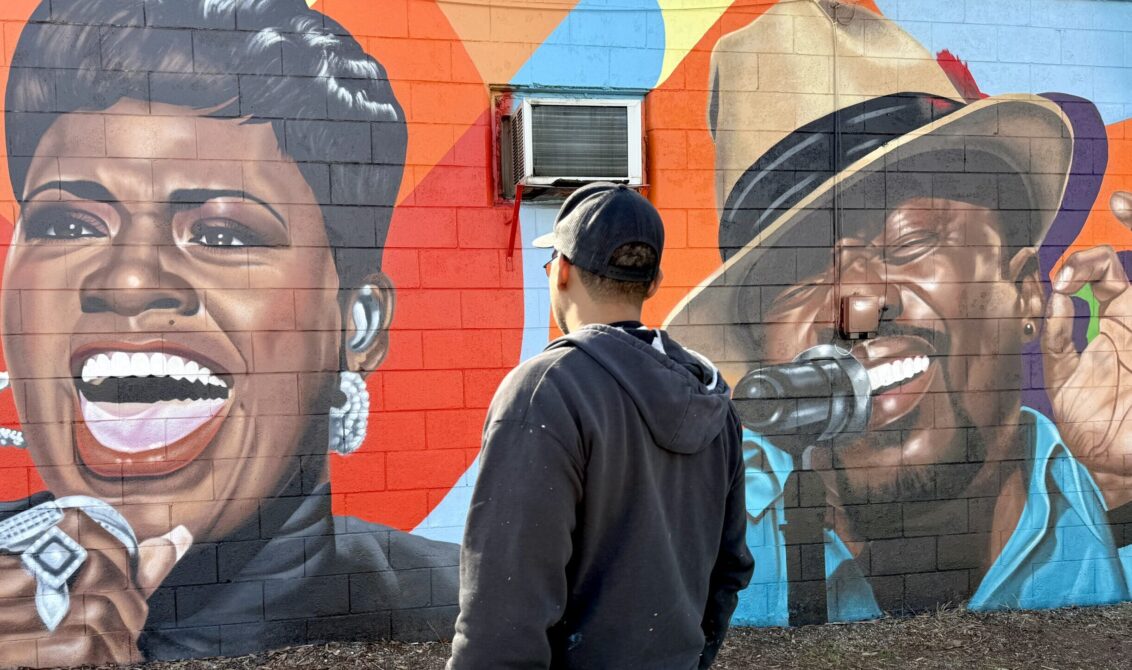 By Cameron Lee
By Cameron Lee
February 10, 2025
When it comes to music history in North Carolina, there haven’t been many artists as influential as Anthony Hamilton, Fantasia, and John P. Kee. When it comes to painting Charlotte’s Black history, there haven’t been many artists as prolific and proficient as Abel Jackson. A Carolina native, Jackson’s works span decades, chronicling both the history of Charlotte and prominent Black figures in the state. His latest mural, located on the side of an unassuming building at 1011 Beatties Ford Road (JJ’s Hair Design), was completed just in time for the start of Black History Month.
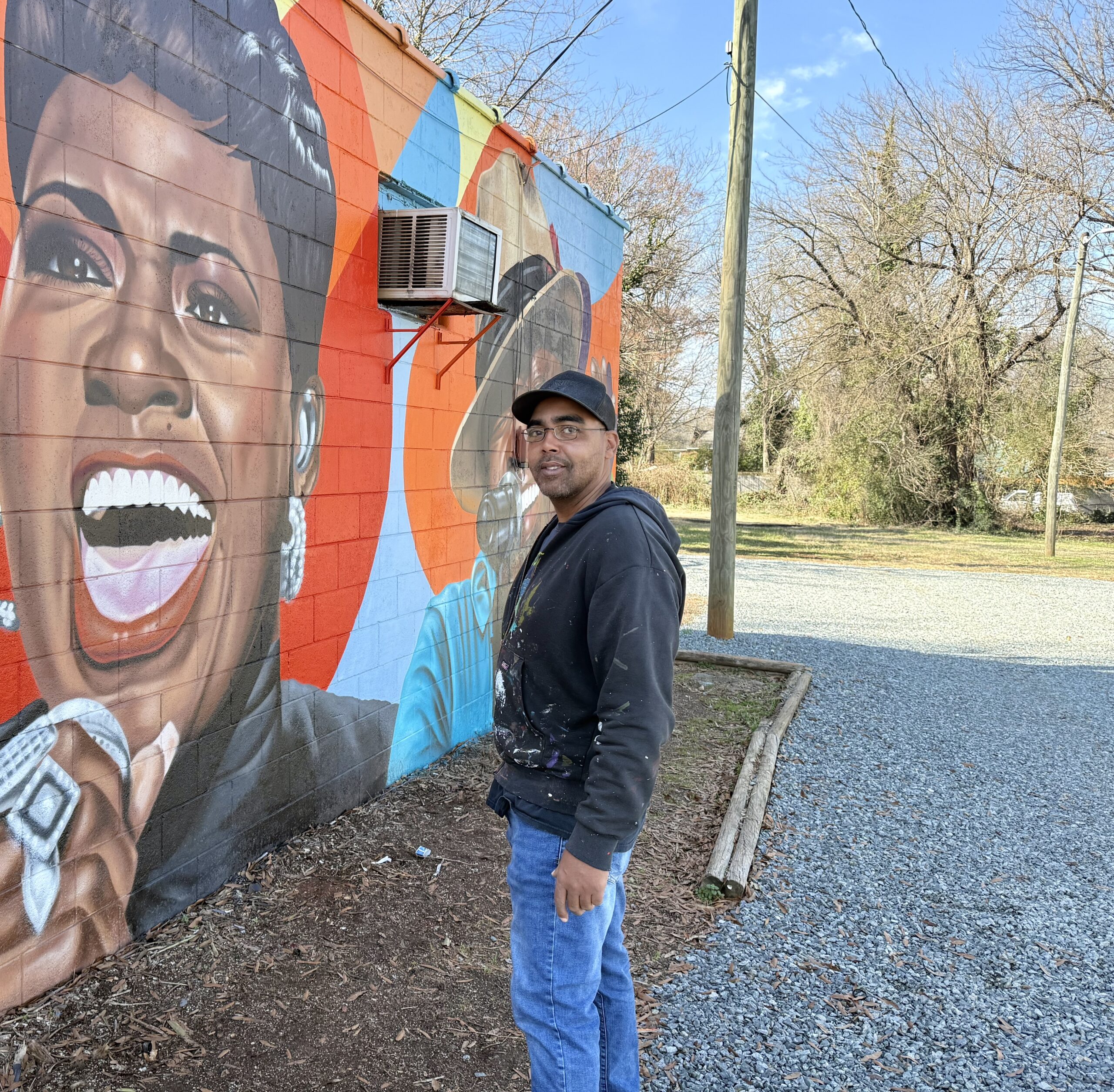
“I grew up listening to John P. Kee, you know, watching Fantasia on American Idol. I remember hearing Comin’ from Where I’m From by Anthony Hamilton — they have music that takes you back to a time period in your life,” said Jackson.
Originally from Greenville, South Carolina, Jackson graduated from Winthrop University with a degree in fine arts and began his career as an independent artist airbrushing apparel at Eastland Mall in the early 2000s. Following a short stint in the corporate world working as a graphic designer for a food services company, airbrushing was the medium he fell in love with. During the height of the Y2K fashion era, when airbrushed clothes and baggy fits were the norm (it’s all coming back now), Jackson was a partner at a retail store called Fresh Air, painting icons like Bob Marley, Aaliyah, Tupac, Biggie, and custom images on jeans, jackets, sneakers, and more.
He eventually moved the business to a storefront on North Graham Street and Norris Avenue, setting up booths at major events and festivals throughout the city. If you were living in Charlotte during the 2000s, you’ve probably seen his work.
Jackson, who now works out of the VAPA Center, is one of the few artists in town who have endured the city’s evolving art landscape. He became more involved with the community with his studio at the Art House in NoDa during the 2010s and later at the creative space Area 15. When many artists were being pushed out of the neighborhood, the soft-spoken Jackson strengthened his ties to the local arts community.
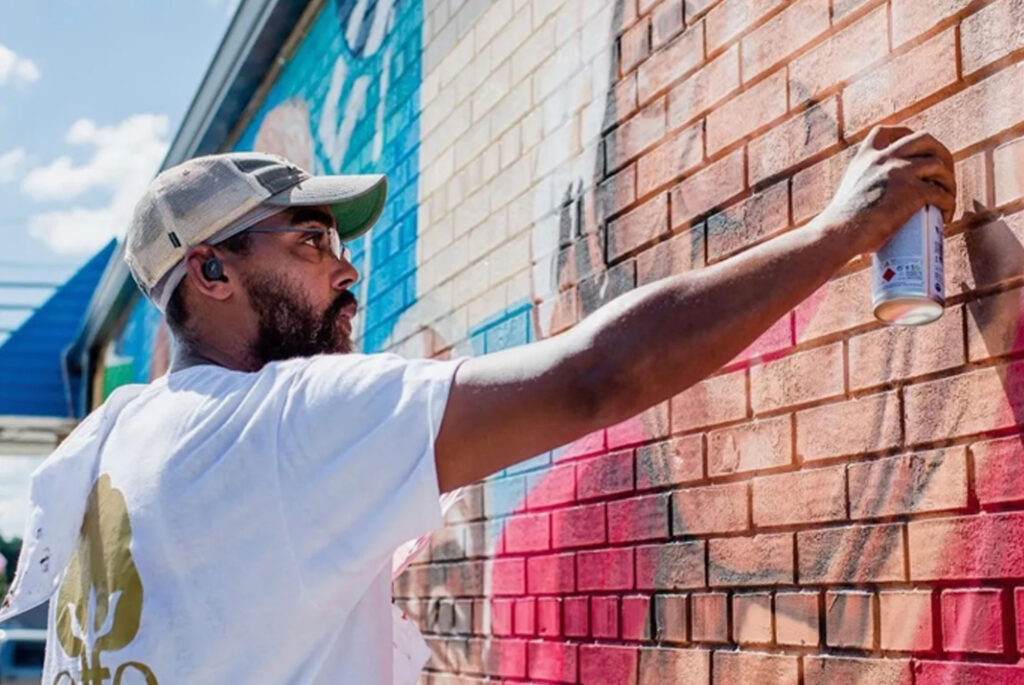
“I started to engage in the greater art scene because it was all centrally located. So that was like the real art scene where everybody was, but then they started running the artists out of NoDa. So everybody kind of dispersed,” he said.
Jackson painted his first big public mural, “West End Perpetual Legacy,” in 2012 at Mosaic Village, paying tribute to symbolic Black-owned and -operated businesses and buildings, such as The Excelsior Club — a prominent social and political gathering space that hosted performances by Sam Cooke, Nat “King” Cole, Louis Armstrong, and James Brown; The Grand Theatre — a cinema serving the Black community from 1937 to 1967 during the Jim Crow era; and the historic Biddle Hall at Johnson C. Smith University. It was recreated in 2020 with the help of Big Trouble Studios on the Arts Factory building at 1545 West Trade Street.
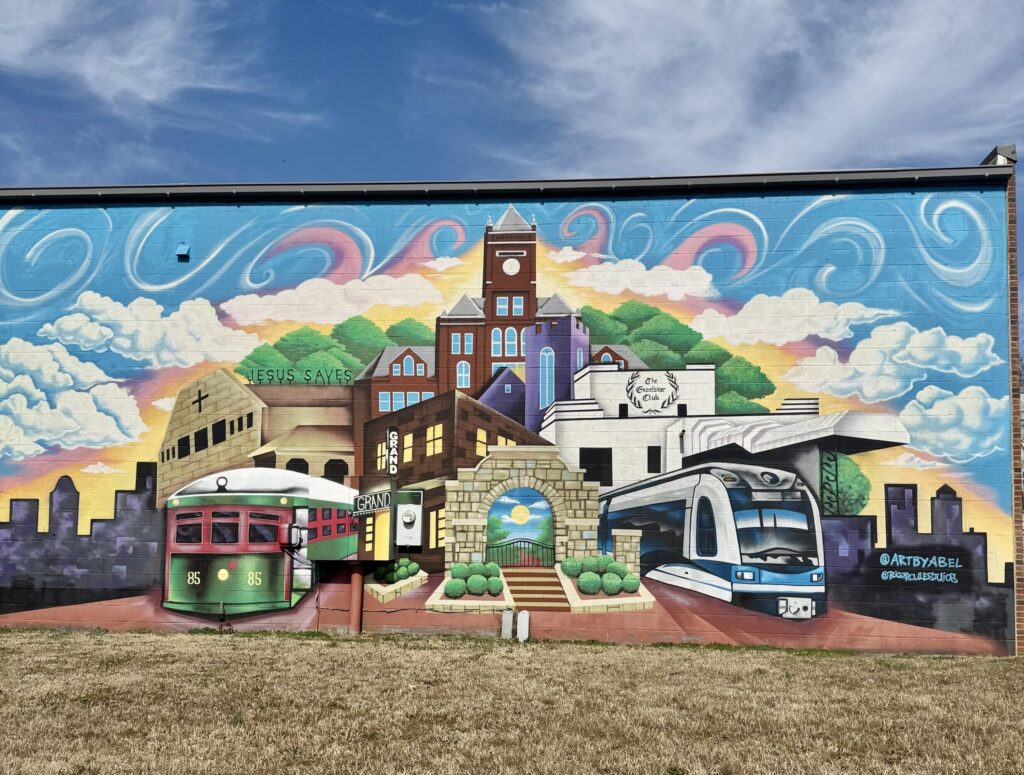
“I’ve been into history in general for a while…looking at it more as, like, self discovery. Charlotte history is Black history, the narratives fit right in when it comes to what happened on a national level over time,” Jackson said.
His mural, “The Great Escape,” completed in 2013, may be his most riveting work to date. The piece, also located in Mosaic Village in Historic West End, details chilling tales of slavery in eight gripping panels. Depicting the journeys of slaves seeking freedom in the mid-1800s, the murals, in collaboration with LATIBAH (Life and Times in Black American History) Collard Green Museum founder T’Afo Feinstein, are accompanied by some elaborate and heroic stories. The project required weeks and some long hours for Jackson to complete. It also took an emotional toll, as ideas and stories came to him after deep research, meditation and prayers, conjuring up sentiments of “fear” and “shame” from his ancestors.
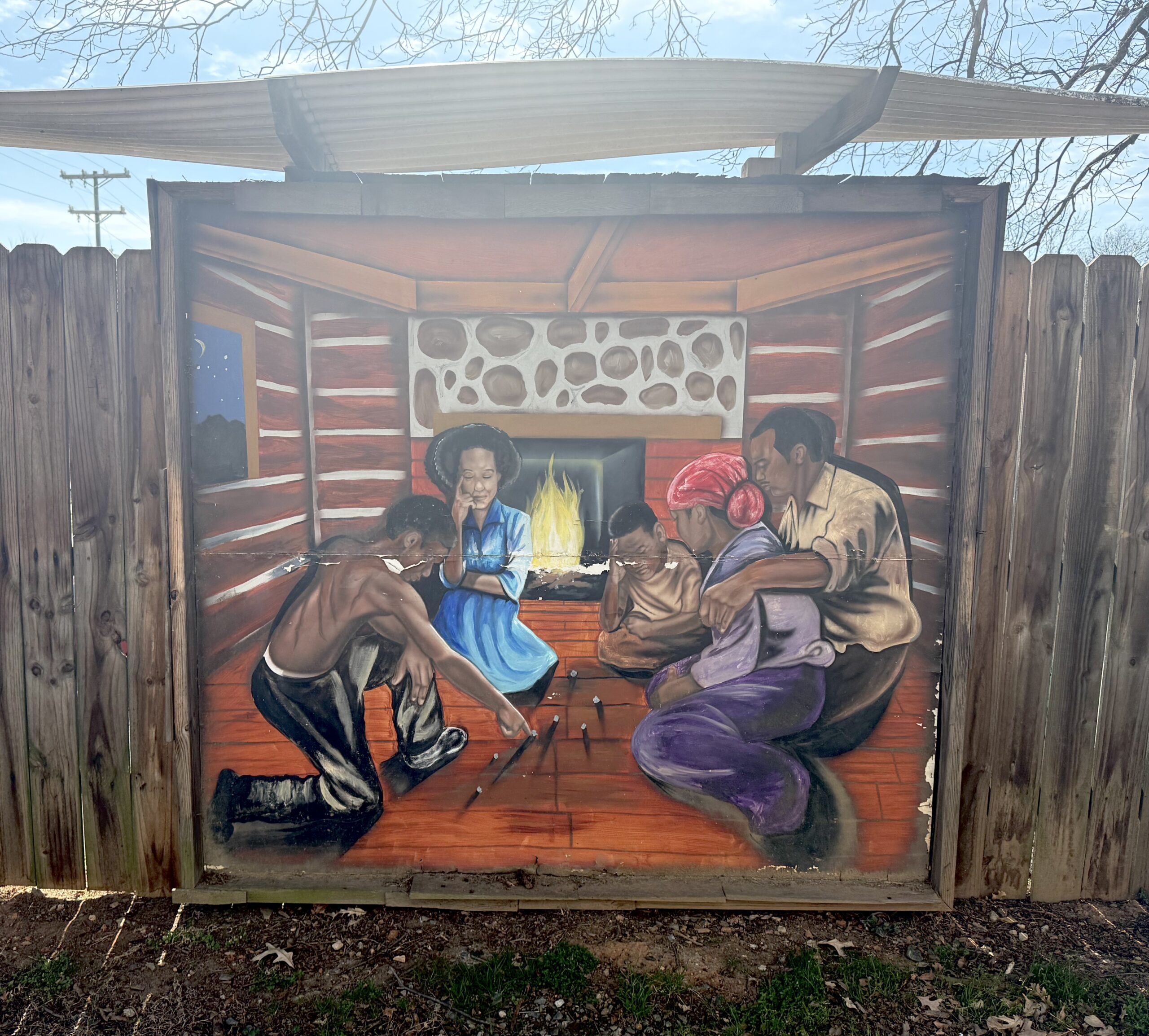
“I just started imagining stuff. So it was almost like going back through time. In order for me to understand what they went through, I had to understand, like, the level of fear that you had to overcome,” Jackson recalls.
His 2019 mural “A City Within A City” commemorates the historic Brooklyn neighborhood of Charlotte with images of prominent civic leaders, educators, and businessmen such as Thaddeus Tate (co-founder of Mecklenburg Investment Company), Dr. John Taylor Williams (one of the first licensed Black doctors in North Carolina), and William Calvin Smith (founder of Charlotte’s first Black newspaper, The Charlotte Messenger). The mural adorns a wall of the old Mecklenburg Investment Company Building, one of the few remaining remnants from the historic Black neighborhood that was demolished in the ‘60s and ‘70s due to “urban renewal.”
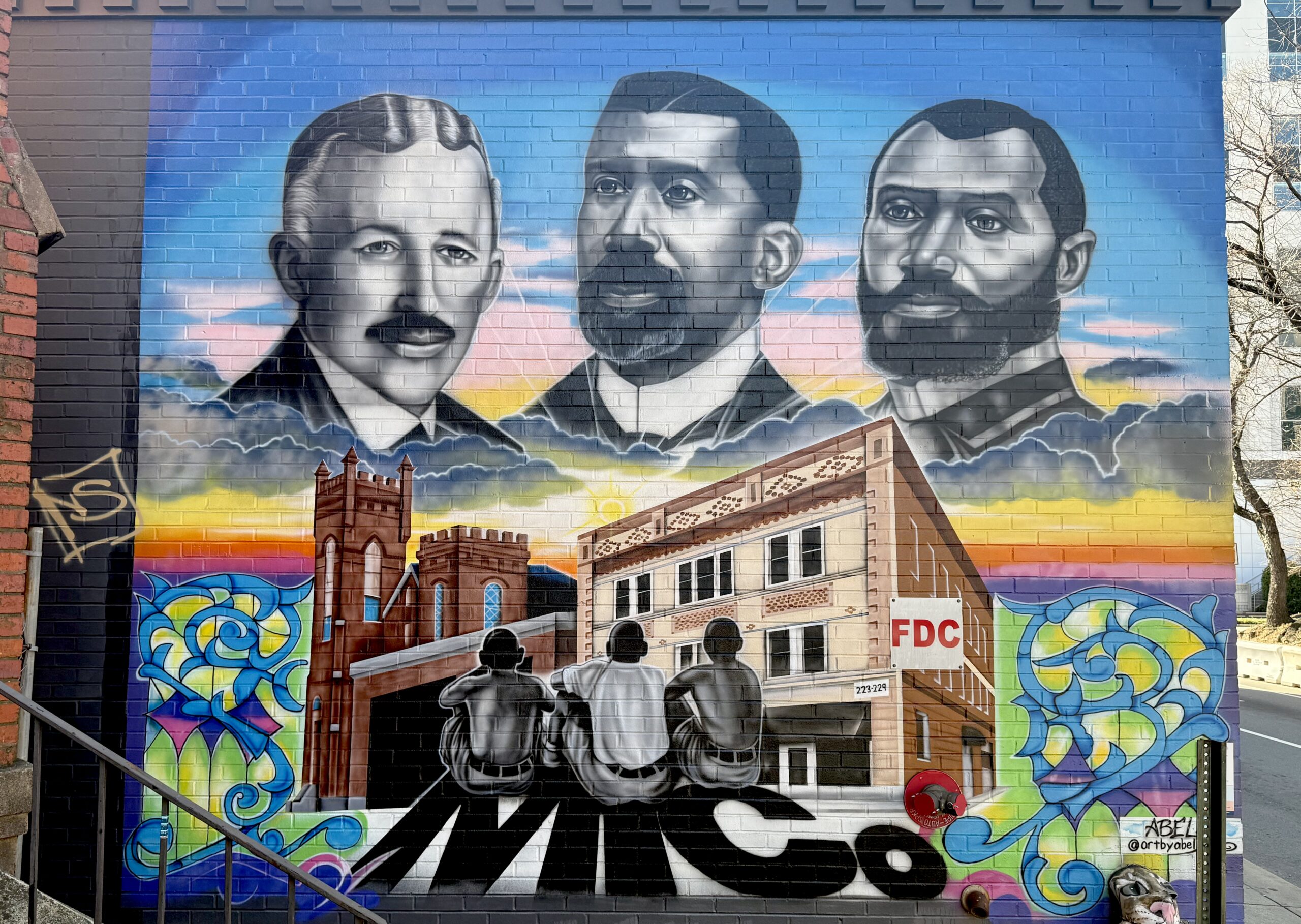
The mural takes the image from a stirring historic photo of three kids observing their school (Second Ward High School) being demolished in 1970, looking up at Tate, Williams, and Smith, who watch over the Grace A.M.E. Zion Church and the Mecklenburg Investment Company Building. It’s a powerful visual that makes you ponder what could have been with a community that was lost, impacting multiple generations.
Wrap around 3rd Street to the back of the building, and you’ll find a stoically dashing image of William W. Smith, a brickmason and contractor, who built the Grace A.M.E. Zion Church and the Mecklenburg Investment Company Building in the early 1900s.
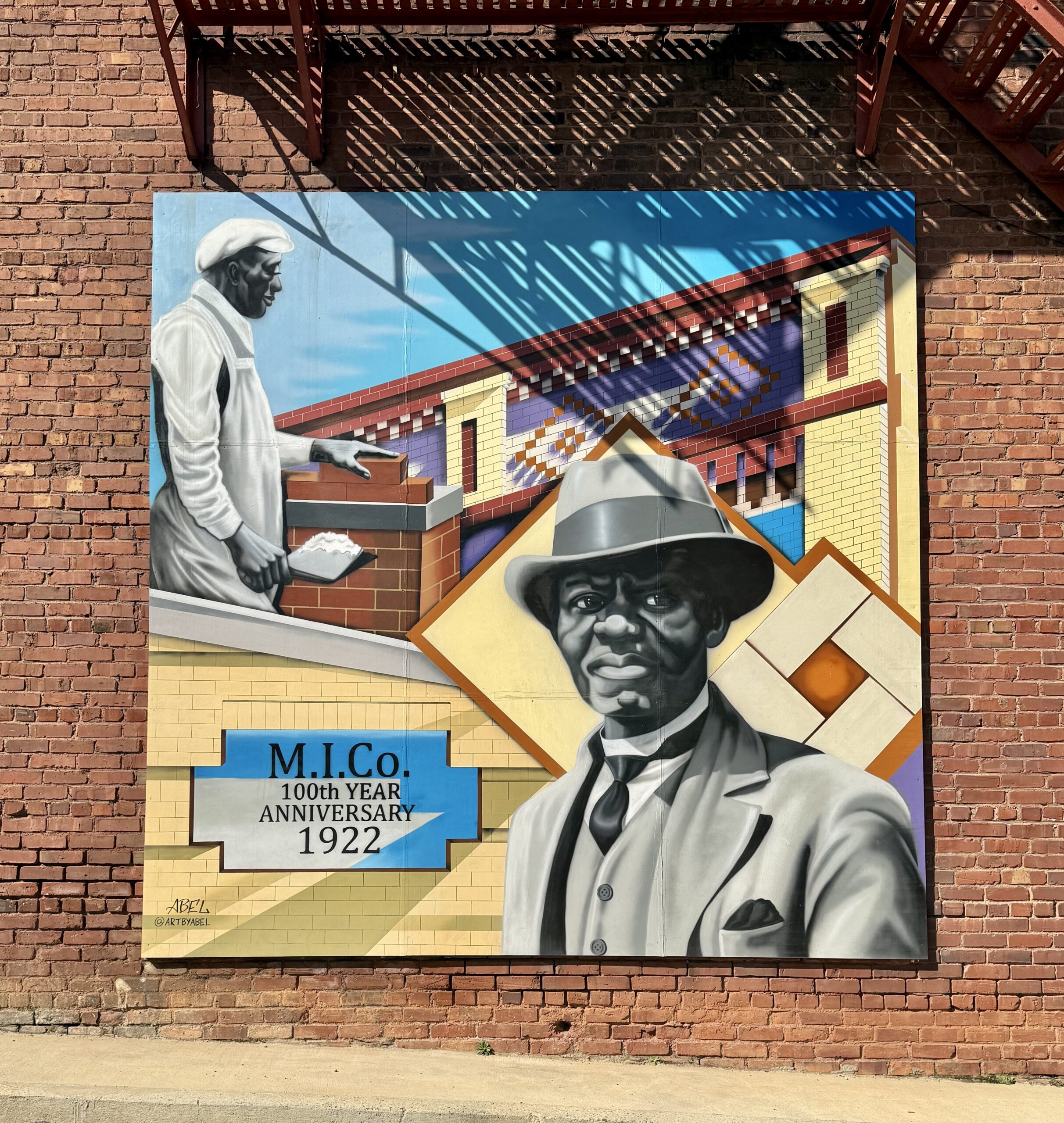
Jackson realizes his pieces have a deeper purpose than just being aesthetically pleasing public works for passersby to gawk at.
“It can function in such a way to spark a person’s interest to look at information, or even give out some information. Spark people’s interest so that they can understand the history, and the individuals involved, and know the area they’re in, and what they are about,” he said.
Jackson’s “River of Life,” was completed in 2021 with funding from a City of Charlotte Placemaking Grant. It graces the West End Fresh Seafood Market off Beatties Ford Road, a West Charlotte staple since 1998 owned by Bernetta and Clarence Powell. Named after a phrase made famous by Reverend Clifford Jones, who said that Beatties Ford Road is “the river of life for the Black community,” the mural honors prominent community leaders such as Bertha Maxwell-Roddey, an educator and co-founder of the Afro-American Cultural and Service Center (now the Harvey B. Gantt Center); civil rights attorney Julius Chambers, a former president of the NAACP Legal Defense and Educational Fund, well known for his work on the Swann v. Charlotte-Mecklenburg Board of Education case; James Ferguson, who co-founded North Carolina’s first integrated law firm with Chambers; Sarah Stevenson, an educator, civil rights leader, and the first Black woman elected to the Charlotte-Mecklenburg school board; Harvey Gantt, Charlotte’s first Black mayor; and Hattie “Chatty Hattie” Leeper, Charlotte’s first Black female radio disc jockey.
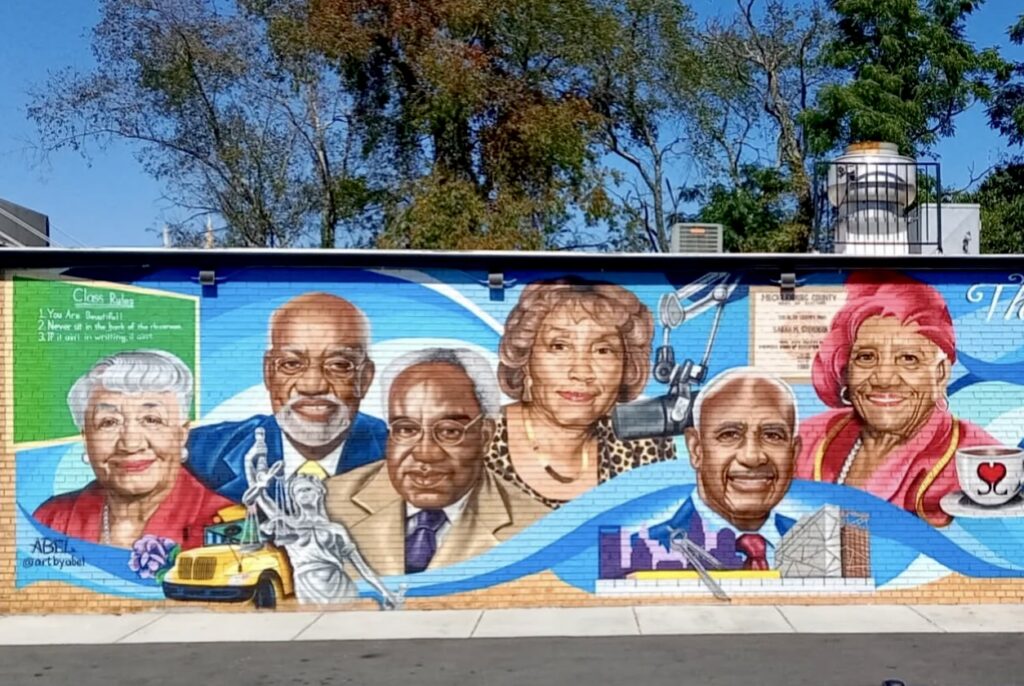
From his 40-foot-wide mural of civil rights activist and attorney J. Charles Jones on West 5th Street and North Bruns Avenue in Biddleville to his sprawling “Past, Present, and Future” painting at the Gantt, Jackson’s works are viewable in several historically significant areas in the city for the Black community. His murals are visual records of the people and places that helped shape Charlotte and a reminder of those who bravely fought for equality.
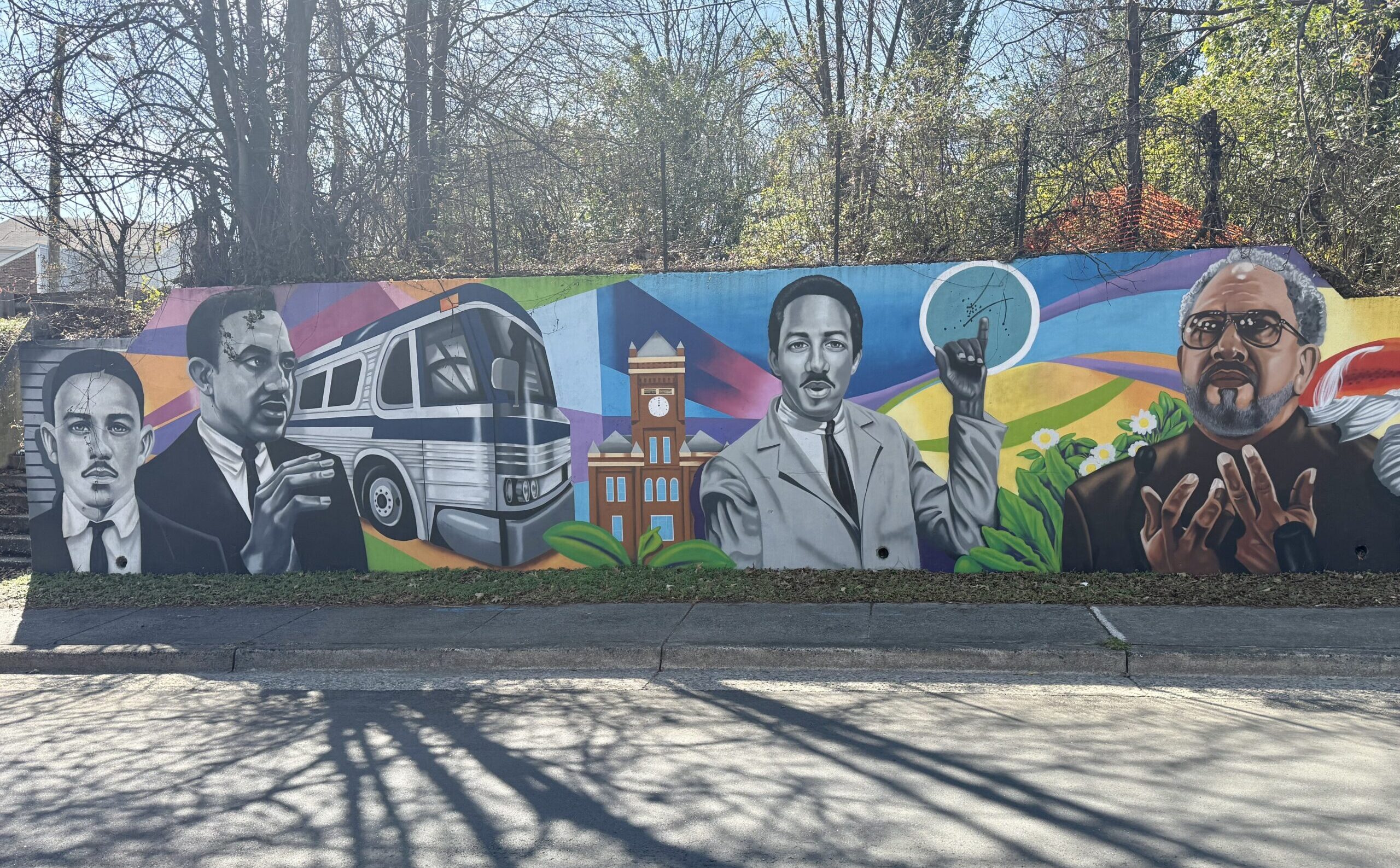
In 2023, he captured a bit of Charlotte’s basketball history at the Spectrum Center, featuring NBA jersey designs from the franchise’s inception as the Hornets in 1988, through the Bobcats era, and the eventual return of the Hornets name. Celebrating the franchise’s 35th anniversary, Jackson used live-action photos of players to convey the motion of the jerseys, creating a striking piece for arena visitors.
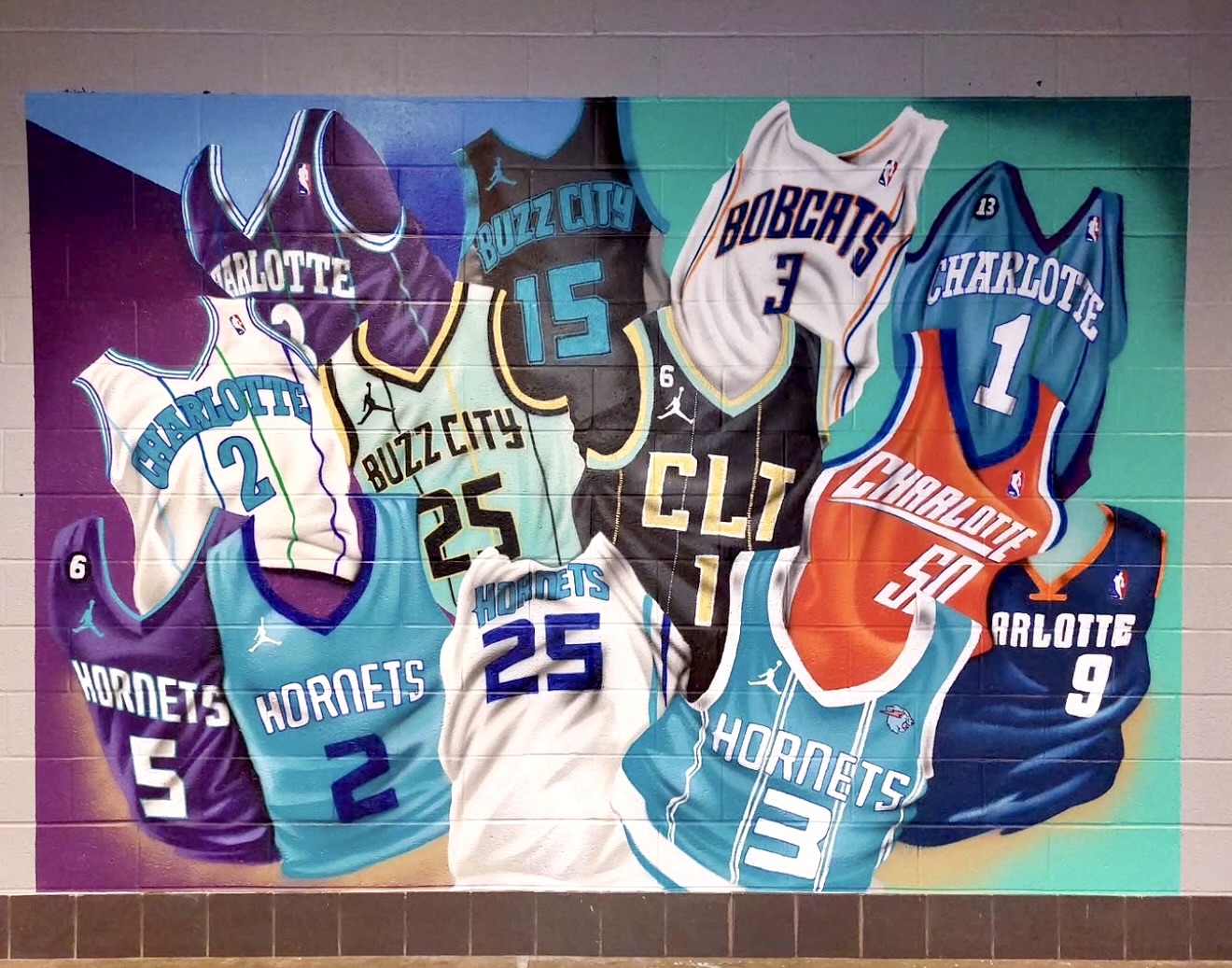
His latest mural of Anthony Hamilton, Fantasia, and John P. Kee has caught the eyes and ears of several music lovers in the state, covering a full wall on the side of JJ’s Hair Design near a somewhat busy intersection on the corner of Beatties Ford Road and Oaklawn Avenue. The mural is catty-cornered to the Original Chicken ‘N’ Ribs, which is one of the few remaining businesses operating in Charlotte from the Green Book, the Black travel guide published between 1936 and 1966. It’s a radiant work of art, with a spectrum of hues creating a vivid backdrop for the lifelike faces of three of North Carolina’s most influential artists in gospel, soul, and R&B.
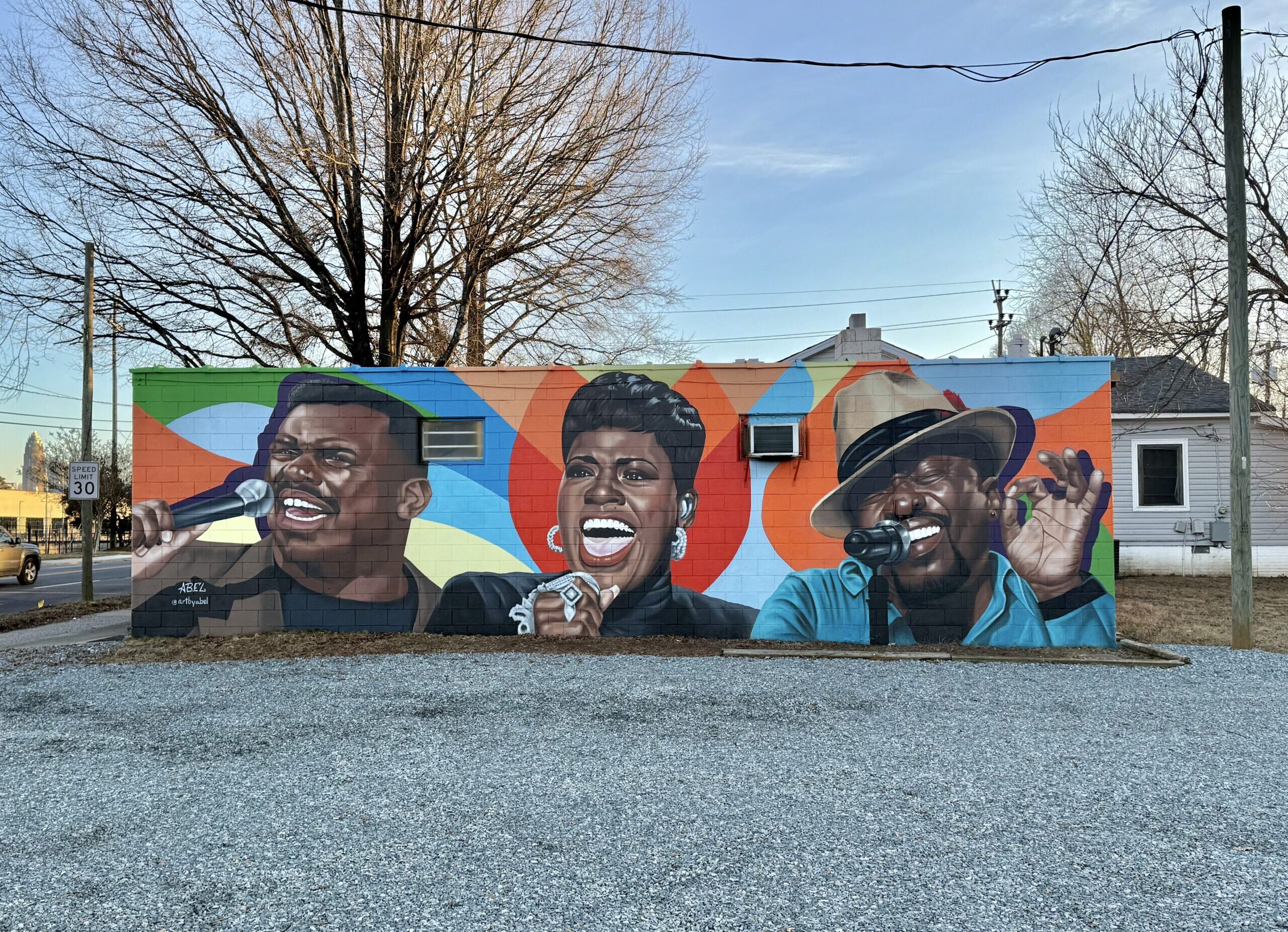
It’s the second of his major works to pay homage to music legends. His “NC 8” mural in collaboration with his mentor T’Afo Feimster, honors North Carolina icons Nina Simone, John Coltrane, Roberta Flack, Thelonious Monk, George Clinton, Chuck Brown, Maceo Parker and Max Roach. The mural, painted against the old A&P Supermarket, funded by The Duke Endowment, Johnson C. Smith and Historic West End Partners, is the only one in the world with this specific grouping of musicians and artists.
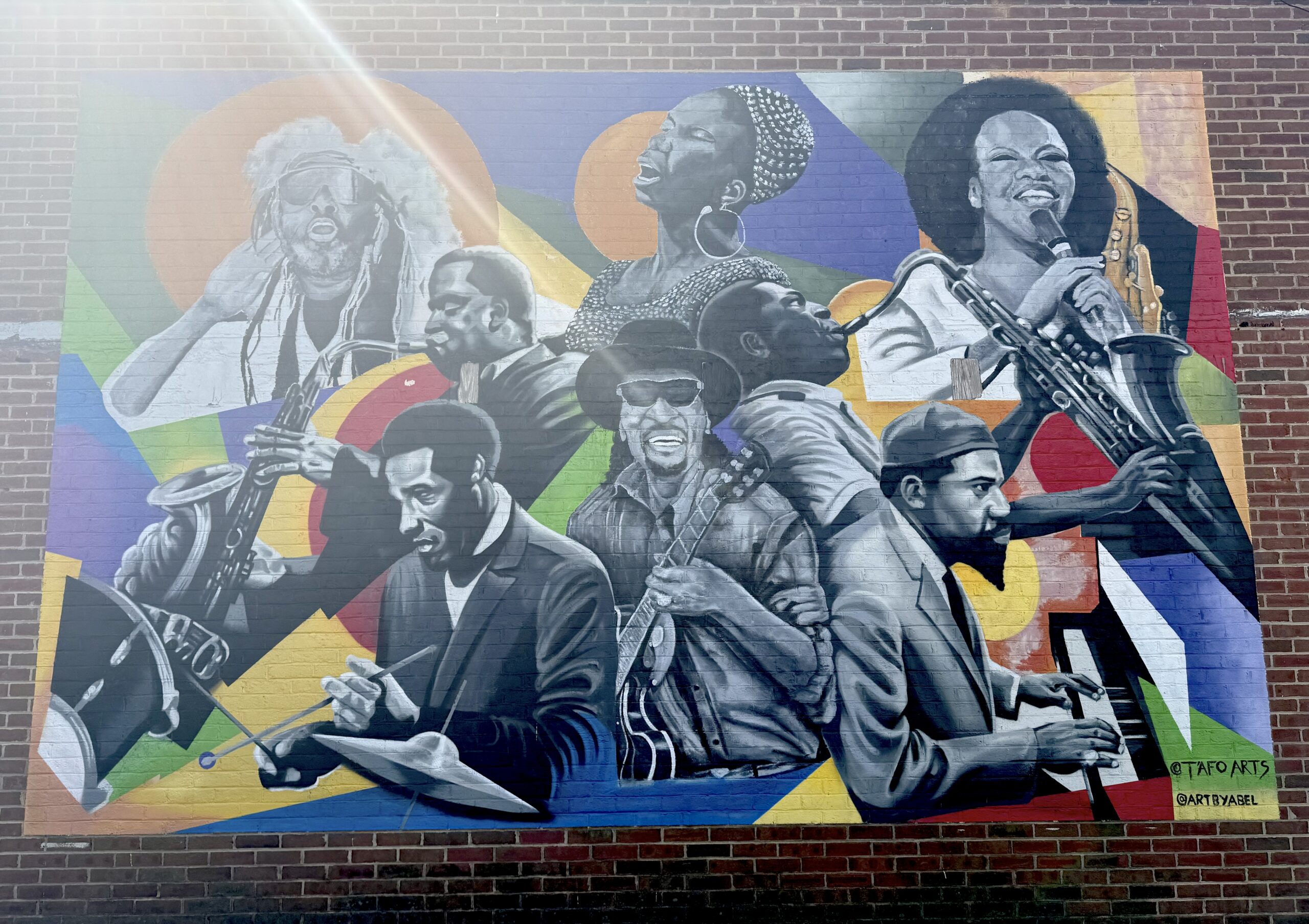
Jackson’s work, with the help of several organizations, has helped tell the stories of the city and state’s Black history, but he wants art to continue to highlight the visionaries who continue to inspire and educate future generations: “I consider history to be like a step in knowing yourself and a step in self-knowledge. So a part of understanding who you are is also understanding your history.”
You can follow Charlotte artist Abel Jackson on Instagram and his official website.
View this post on Instagram
Read next:
